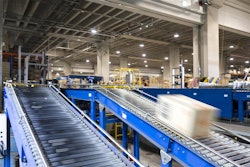Profiles in Supply Chain Enablement: Appliance manufacturer upgrades its enterprise systems and sees revenues double as business expands
Company: BP Castrol (Milan, Italy)
Company Size: Large
Company Sector: Manufacturing
Area(s) of Enablement: Order/Demand Capture, Supply Chain Integration & Infrastructure
Enabler: ToolsGroup (Boston, MA)
 Case Study: The Challenge
Case Study: The Challenge
Alessandro Tenaglia was charged with leading a demanding project to overhaul Castrol's forecasting and replenishment systems in Europe. When his team took over, they were faced with reactive supply chains caused by forecasts that were inaccurate, unreliable and incomplete. Inventory levels in the supply chain were off by a wide margin because safety stocks had been set manually based on intuition and had been infrequently adjusted since.
As a result, fast-moving products were constantly out-of-stock, and most slow-moving products had excess inventory. Planners were expediting constantly to overcome the poorly derived inventory targets. Finally, the team was faced with multiple enterprise resource planning (ERP) systems, countries, currencies, languages and business procedures.
The Solution
Alessandro and his team built an effective demand, inventory optimization and replenishment planning process, which they implemented in one country and rolled our across Europe. The resulting system coordinated ten independent systems into one global and unified coherent planning process. It encompasses the "downstream" portion of Castrol's supply chain, from blended oils and packaging through to the end user customer. There is now a single point of accountability for delivering a robust and reliable forecast. Appropriate inventory levels insure high service levels to customers, and have reduced stock-outs and manual expediting.
Castrol was also one of the first companies to employ stochastic modeling technology to manage the uncertainty in the supply chain. Many companies try to reduce supply chain uncertainty by improving forecasts. Castrol realized that to optimize inventories chain they also needed to properly manage the remaining uncertainty in the supply chain.
The company worked with ToolsGroup to build a system that employs stochastic modeling techniques to accurately measure demand and supply chain volatility and accurately set inventory targets required to accommodate the volatility. The resulting system has allowed then to deliver extremely high customer service levels, despite a complex multi-echelon distribution networks.
The Result
As a result, the Castrol project team reduced total network inventories by 35 percent, 20 percent in the first year after implementation and then 20 percent again in the following year. Despite the lower inventories, service levels to customers, as defined by "line fill rates," is up by 9 percent overall. Aggregate forecast accuracy has improved by 15 percent on average.
In addition, this system has become a unique company standard for excellence in forecasting, customer service level planning and inventory optimization. The system now spans 29 installations, 25 countries and two continents. Further deployments in the marine division and to the parent company, BP, are planned. "We've seen dramatic increases in our service level with significant reductions in inventory across Europe," said G. Chick, Central Europe supply chain director at the company.
For more stories of successful supply chain implementations, read the "2005 Supply & Demand Chain Executive 100" article in the June/July 2005 issue of the magazine. Also watch the Today's Headlines section of SDCExec.com every Tuesday and Thursday for more in depth best practices drawn from this year's Supply & Demand Chain Executive 100.
Company: BP Castrol (Milan, Italy)
Company Size: Large
Company Sector: Manufacturing
Area(s) of Enablement: Order/Demand Capture, Supply Chain Integration & Infrastructure
Enabler: ToolsGroup (Boston, MA)
 Case Study: The Challenge
Case Study: The ChallengeAlessandro Tenaglia was charged with leading a demanding project to overhaul Castrol's forecasting and replenishment systems in Europe. When his team took over, they were faced with reactive supply chains caused by forecasts that were inaccurate, unreliable and incomplete. Inventory levels in the supply chain were off by a wide margin because safety stocks had been set manually based on intuition and had been infrequently adjusted since.
As a result, fast-moving products were constantly out-of-stock, and most slow-moving products had excess inventory. Planners were expediting constantly to overcome the poorly derived inventory targets. Finally, the team was faced with multiple enterprise resource planning (ERP) systems, countries, currencies, languages and business procedures.
The Solution
Alessandro and his team built an effective demand, inventory optimization and replenishment planning process, which they implemented in one country and rolled our across Europe. The resulting system coordinated ten independent systems into one global and unified coherent planning process. It encompasses the "downstream" portion of Castrol's supply chain, from blended oils and packaging through to the end user customer. There is now a single point of accountability for delivering a robust and reliable forecast. Appropriate inventory levels insure high service levels to customers, and have reduced stock-outs and manual expediting.
Castrol was also one of the first companies to employ stochastic modeling technology to manage the uncertainty in the supply chain. Many companies try to reduce supply chain uncertainty by improving forecasts. Castrol realized that to optimize inventories chain they also needed to properly manage the remaining uncertainty in the supply chain.
The company worked with ToolsGroup to build a system that employs stochastic modeling techniques to accurately measure demand and supply chain volatility and accurately set inventory targets required to accommodate the volatility. The resulting system has allowed then to deliver extremely high customer service levels, despite a complex multi-echelon distribution networks.
The Result
As a result, the Castrol project team reduced total network inventories by 35 percent, 20 percent in the first year after implementation and then 20 percent again in the following year. Despite the lower inventories, service levels to customers, as defined by "line fill rates," is up by 9 percent overall. Aggregate forecast accuracy has improved by 15 percent on average.
In addition, this system has become a unique company standard for excellence in forecasting, customer service level planning and inventory optimization. The system now spans 29 installations, 25 countries and two continents. Further deployments in the marine division and to the parent company, BP, are planned. "We've seen dramatic increases in our service level with significant reductions in inventory across Europe," said G. Chick, Central Europe supply chain director at the company.
For more stories of successful supply chain implementations, read the "2005 Supply & Demand Chain Executive 100" article in the June/July 2005 issue of the magazine. Also watch the Today's Headlines section of SDCExec.com every Tuesday and Thursday for more in depth best practices drawn from this year's Supply & Demand Chain Executive 100.









